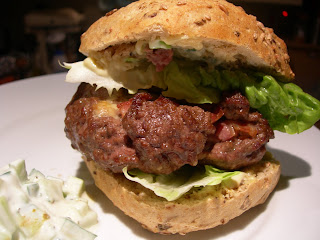I first bought delicious. magazine in early 2004, just after I'd started reading Good Food and Olive. I could probably have done without yet another food magazine, but I didn't realize that at the time, or perhaps I did and I bought it anyway. I've gone through phases with all three of these magazines - oh and I've also bought fresh, which I found had an irritating typeface and too much about growing, rather than cooking, food (that issue may not have been typical) and Donna Hay's magazine, which I confess to liking because it is so beautifully stylised, but the import price is quite prohibitive. At first my favourite magazine was unquestionably delicious., followed by Olive and Good Food, but the formats of all seem to change regularly and they each appeal more to me at certain times. In terms of delicious., I've noticed that where I used to cut out and try lots of recipes, now I try very few and sometimes none. Admittedly this may be a side effect of the Jamie project, but I suspect it is more than that; certainly I haven't discovered any amazing new dishes recently, whereas I did in the earlier days. I enjoyed 'Jamie's quickies', the cut out and keep recipe cards, and tried lots of them; I often tried recipes by Jill Dupleix (her sausage and red wine pasta is fantastic) and I am still making lots of their barbecue recipes from summer 2005. Thus when I saw '5 of the Best', recipes from delicious., I was eager to see which recipes Valli Little had picked out as favourites.
The premise of the book is simple and effective: it covers a range of categories (salads, cold and hot soups, eggs, boiled pasta, baked pasta, savoury tarts, pizzas, rice, vegetarian, potatoes, vegetables, white fish, salmon, chicken, beef, lamb, pork, stir-fries, casseroles, curries, sweet tarts and pies, cold desserts, cheesecake, ice-cream and semifreddo, hot puddings, pikelets and pancakes, big cakes, small cakes) and includes, for each category, five of the most popular or successful recipes from either Australian or British delicious. Given this background, we can have full confidence that the recipes are likely to work.
The book is beautifully laid out, with an image for every recipe; the photographs are almost all extremely appealing. The pages feel spacious; words and images are not clamouring for space. The food looks simple but stylish, the sort of food you want to cook.
The recipes vary, from comforting British-style food to the Australian sunshine food I associate with Bill Granger and Donna Hay; there are a lot of healthy-seeming recipes, but a good range of desserts too. They all look pretty straightforward; there are no endless lists of ingredients and a cursory read-through suggests that these are mostly pretty accessible.
I've tried a couple of recipes. One is the chicken with pesto and mascarpone, which I mentioned in an earlier post:

The chicken is stuffed with a mixture of pancetta, breadcrumbs, onions, parsley, Parmesan and egg, roasted, and served with a sauce made from pesto, white wine and mascarpone. It was delicious!
My second dish was a beef stirfry. I know stirfries aren't exactly foodie news, and like everyone else I lived on them and pasta when I was a student, because they were cheap and quick. I've made a few stirfries recently, in the interests of saving time after a long day at work, and realized two things: a) that I really like trying new stirfries out and b) that my Le Creuset frying pan doesn't do a great stirfrying job. Yesterday we bought a new, electric wok, in the Fenwicks household event so my stirfries will be much enhanced in future. Anyway this one I made in my frying pan... It was basically beef, rolled in peppercorns, five-spice and groundnut oil, stirfried and then roasted in the oven briefly, with stirfried spring onions, garlic, chilli, ginger, noodles , cashews and spinach, and tossed with a sauce made from soy, sugar, oyster sauce and sesame oil. It was easy and tasty - what you'd expect from a book that comes from a magazine like delicious. - without being anything particularly different. Good weeknight fare, anyway.

The cashews lift this dish, I think, mainly because I'm a bit of a cashew fan. The recipe said hokkien noodles, but I just used what we had in the house. I think the biggest compliment I could pay this dish, though, is that I hadn't stirfried for ages - thanks to not having a wok and just an expensive Le Creuset frying pan that stirfrying probably doesn't do any good to - and that I've made two since (blog report to come). This book may not contain the recipes I have taken to heart from delicious., but that's all to the good, really; it has recipes I may have missed the first time, for one reason or another, and it's nice to give them a try now.

































